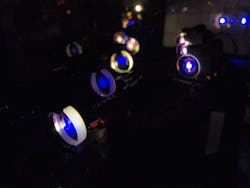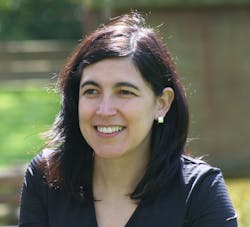For Rosa Romero, CEO and co-founder of Sphere Ultrafast Photonics, the path to success has never been a straight line. Starting her PhD in 2001, the year of the telecom bubble bust, she was forced to navigate a rapidly changing, turbulent industry from the start. Yet, her love and passion for photonics kept her focused on the path ahead, motivating her to move forward.
With hindsight being 20/20, Romero recognizes that entering the field at such a tumultuous time gifted her a unique perspective, allowing her to forge her own path. Now, as the CEO and co-founder of a company at the forefront of popularizing and commercializing ultrafast laser technologies, she reflects on her experience, and considers what she and her company can do for the future of photonics.
Wading into photonics
A native of Galicia, Spain, Romero had strong aspirations from her early days but was unclear on her direction. As a student at the University of Santiago de Compostela, she had strongly considered becoming an architect but instead discovered a passion in the polarization of lasers while working on her Master of Science degree. After realizing a love for lasers, Romero ultimately decided to pursue her PhD in photonics engineering. However, by her own account, at the time, she felt there was a limited photonics industry in Galicia. So, she pivoted, attending the University of Porto in Portugal, striving to remain close to family.
As a PhD candidate, Romero also served as a member of the university’s faculty, where, though she worked with limited resources, she had the benefit of a lot of autonomy, allowing her freedom to explore concepts that appealed to her—which would come in handy in the future.
In addition, her time at the University of Porto led to her engagement in an international training program. This program not only allowed her to travel all over Europe and meet laser science experts. But, it also gave her access to experiments in laboratories across the continent, offering a line of sight into the evolution of laser research in several fields.
That early enthusiasm for the field remained, but as she wrapped up her PhD in 2005, she was unsure of what was next. She continued as a postdoctoral researcher, but began to feel stifled by the academic environment. Romero longed for a more entrepreneurial path, one where she would have the ability to take an idea or concept and follow it to its natural conclusion.
To attain that flexibility, she shifted her focus to the private sector, becoming a member of a research and development team at Multiwave Photonics. Over five years, Romero worked her way up, becoming a senior optical engineer. Then, in 2012, the company dismissed all its employees as part of an organizational restructuring, sending her back to the drawing board.
Taking care of business
That shake-up was what Romero needed to pivot toward a different path: She returned to Porto to study business, becoming one of the few at the top of her field to pursue a Master of Business Administration (MBA). That work shed a whole new light on her career trajectory. Even today, Romero shares, many scientists lack the necessary business skills and acumen to take their ideas to the market. This work on the business side helped her combine her research prowess with her experience in the private sector to begin uncovering a path that married photonics innovation and ideas with the business communities’ needs.
Fate may also have been on Romero’s side. Around the same time, Helder Crespo, co-founder of the University of Porto’s Ultrashort Pulse Laboratory, approached her, asking if she was interested in starting a company. That possibility spoke to a culmination of her passions, tying her business skills with a photonics vision, and through a collaborative effort, Sphere Ultrafast Photonics was born, with Romero as the CEO from day one.
So, while advancing her MBA studies, Romero did everything necessary to build the company’s foundation. She worked on the strategy, business model, and business plan, all while completing her workload for her degree. And, to formally kickstart the company, Romero began working on a proof of concept for a European Research Council grant. Romero recalls that during this project, she started working with Anne L’Huillier, head of the atomics and physics department at the University of Lund, a member of the Nobel Prize Committee and future Nobel Prize winner.
Despite the countless hours the pair put into the project, they were denied the grant. Again, Romero went back to the drawing board and, with the help of L’Huillier, submitted the design a second time. This time, the company was awarded the resources to build its first demo model. Finally, Sphere would have a physical product to show off to potential clients, and Romero could get down to business.
Where to locate the business became another factor of consideration. Sphere Ultrafast Photonics was based in Portugal, while most of its clients were international buyers. Traditionally, companies like hers first sell domestically and later tap into the international market. Unfortunately, the photonics market in Portugal was extremely limited, meaning that Sphere would have to be, as Romero puts it, “born global.” It would have to build a strong presence in the photonics community to get off the ground and truly take off. Fortunately, with the help of her colleagues’ reputations (and letting her work speak for itself), Sphere held its own within the photonics community.
Romero also explains that at Sphere Ultrafast Photonics, the client is—and has always been—the priority. Not only does the company construct its products around the needs of its customers, but it does so for customers working at the forefront of their industries, such as in microscopy. With this client-centric model, Romero and Sphere Ultrafast Photonic provide for the client’s specific needs, allowing the company to pivot and tailor its solutions to market demands.
Ahead of the curve
The path hasn’t been linear, though. As the company began its rise, another challenge put its future in jeopardy, one that Romero was familiar with: introducing a new product to an existing market.
Romero had experienced this issue in her previous position. While the company had innovative designs for the time, it launched products that the market couldn’t yet accommodate. Thus, it struggled to establish a consumer base. To avoid the same fate, Sphere Ultrafast Photonics focused on diagnostics and implementing lasers built by separate manufacturers, rather than developing a home-run product. This way, Sphere could take a small bite out of the market, without worrying about product support issues.
Nevertheless, Romero and Sphere Ultrafast Photonics still had a tall task ahead of them. They needed to establish a footing in a very niche market, create a trademark, and build the technology to run diagnostics in the first place. Thanks to Romero and her colleagues’ deep knowledge of the scientific community, this task proved more feasible than it appeared at first glance. After considering the worldwide quantity of laboratories and femtosecond lasers, as well as the price ranges of their competitors, Romero knew that the company had a market, and would be around for the long term. After gathering with the company’s champions and leaders, Romero knew Sphere Ultrafast Photonics was ready to set sail.
An evolving market
While the market remains somewhat small, Sphere Ultrafast Photonics has firmly established its place within the photonics industry, becoming an increasing presence over the past decade-plus. The company remains vibrant and continues to adapt its solutions to the needs of its customers and offer answers to challenges meeting the larger landscape.
Reflecting on the current trajectory of Sphere Ultrafast Photonics, Romero sees its continued climb. In 10 years, she predicts Sphere will triple in size, attributing most of this expansion to the evolution of the photonics market. More specifically, she hopes that ultrafast lasers will expand their practical applications outside the laboratory.
Of all the thriving sectors with a stake in the photonics market, Romero believes one area, in particular, will be the most explosive in the coming years: microprocessing. While the potential for the market is currently limited, Romero believes that a breakthrough in photonics is on the near horizon and will drastically expand the target audience of these technologies. She explains how she sees a future where the average consumer can utilize photonics to complete activities as ordinary as computer maintenance.
What exactly is the key to the future growth in consumerized photonics? If you ask Romero, she will tell you that lies in the work of Sphere Ultrafast Photonics and others like it. The current problem, she explains, is that the entrepreneurs looking to create new products often don’t have the knowledge or means to utilize ultrafast laser technologies properly. Sphere Ultrafast Photonics can provide the technology to make the control of these lasers as straightforward as possible.
Like everything else, though, this change takes time. As a new generation of entrepreneurs is born, Romero’s advice for success in the industry is this: if you think you can do it, do it. She explains that even if others say an idea is too difficult to pursue, has too many logistical issues, or currently lacks a market, you should still pursue the idea.
That sense of perseverance and certainty of vision has served her well over the years, and when you look at how Romero’s journey has evolved, it’s hard not to agree that going all-in makes the difference.
About the Author
Jose Pozo
Chief Technology Officer, Optica
Jose Pozo joined Optica in March 2022, and has spent more than 25 years working in photonics. He earned a PhD in quantum physics from the University of Bristol (U.K.), and an M.Sc. and B.Eng. in telecom engineering from UPNA, Spain / VUB (Belgium). Prior to joining the European Photonics Industry Consortium (EPIC) in 2015 as CTO, Jose was a Senior Photonics Technology Consultant with PNO Consultants, with some of the main accounts such as CERN, Thales, and TE Connectivity. He has worked at TNO, The Netherlands Organization for Applied Scientific Research, and as a postdoctoral researcher at the Eindhoven University of Technology in the Netherlands, where he contributed to the early development of EFFECT Photonics.

